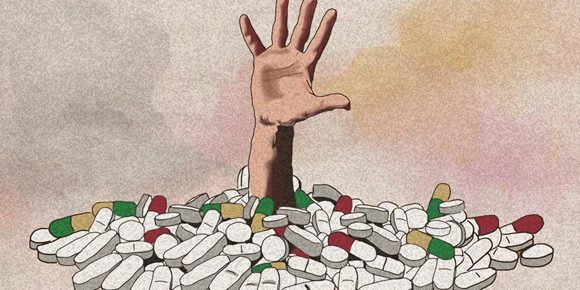This past July I suffered a severe injury to my back. I stubbornly tried (unsuccessfully) to lift a heavy glass dining table leaf—not once, but twice. On the second try, I felt a tear horizontally along my back.
I had just managed to herniate a lumbar disc and pinch a nerve that sent electric shocks of misery down the front of my left thigh. Never having suffered back pain before, I had no idea what I was in for—pain shots, x-rays, MRI, wheelchair, walker, cane, 5 months of physical therapy, and being temporarily disabled for the first time in my life. My doctors prescribed opioids to help me cope with the two-pronged agony of back and leg pain.
Despite the pain, I was hesitant to take those opioids. I had read and heard how quick and easy it was to become addicted. But the hesitation was short-lived. Though I’m a pretty tough cookie when it comes to pain, I surrendered and soon embraced and appreciated the relief from those opioids for three and a half weeks. Luckily, I was then able to stop taking them and use other pain relief methods (including Bio-Touch) with no ill effects.
Opioids are either natural, partially synthetic, or synthetic drugs derived from the poppy plant or chemically synthesized in laboratories. They are a class of drugs, both legal and illegal. Legally prescribed opioids include morphine, codeine, and oxycodone. Illegal opioids include heroin.
Opioids help people cope with pain. They bind to natural opioid receptors in the brain, mimicking specific chemicals that are related to sensations of pain relief, pleasure, and reward. When used as prescribed, legal opioids are one of the most effective forms of pain relief. But, since opioids have both pain-relieving properties and positive psychological properties, they are among the most abused substances currently available.
In 2016, 2.1 million Americans, aged 12 and older suffered from an opiate addiction. Approximately 600,000 were dependent on heroin and 1.5 million on prescription drugs. At its peak, more than 259 million prescriptions for opiate painkillers were written in the U.S. in 2012.
When taken as prescribed by a doctor, the potential for abuse and addiction is low, but used improperly, opioids can lead to physical dependence within 4-6 weeks. Psychological addiction can result in as little as two days.
Drug overdose is the leading cause of accidental death in the U.S. and opiates account for at least 70 percent of those casualties.
Some of the side effects of opioid use include:
- Fatigue/drowsiness
- Constipation
- Breathlessness
- A sense of elation
- Bronchospasms -sudden restricted breathing
- Physical and psychological dependence
- Nausea
- Confusion
- Mood swings
- Depressed respiration
- Chest pain
- Death (often due to use of more than one substance)
Opioid withdrawal symptoms:
- Agitation
- Anxiety
- Runny nose
- Sweating
- Muscle aches
- Insomnia
- Abdominal cramping
- Diarrhea
- Dilated pupils
- Nausea
- Vomiting
Bio-Touch has been shown to alleviate symptoms and side effects associated with opioid use and/or addiction. While not a substitute for standard medical care, Bio-Touch is an effective complement to medical protocols. Family members and friends can learn how to help each other feel better using Bio-Touch, without being concerned about negative side effects.
The Bio-Touch organization is offering a workshop at the Center in Tucson on Thursday April 25th from 6-8PM. Workshop attendees will learn the Bio-Touch points necessary to address the opioid use addictions. More information or register: click here
So, come and bring your family and friends to the Center at 5634 E. Pima St. in Tucson. It’s so rewarding to share Bio-Touch. You’ll feel the power in your fingertips!

